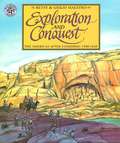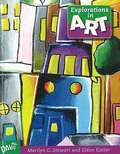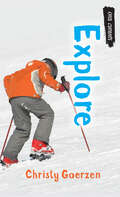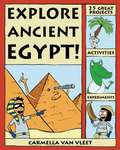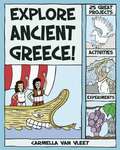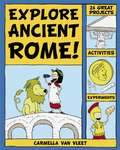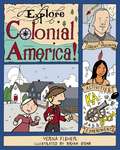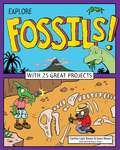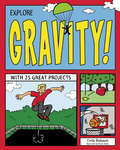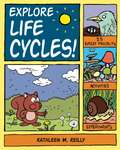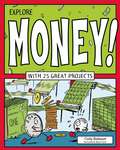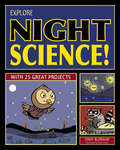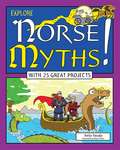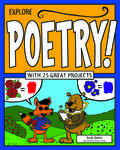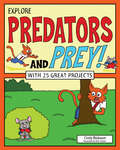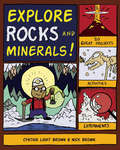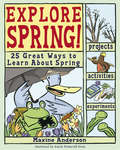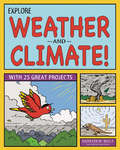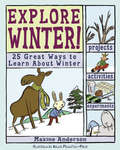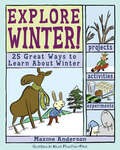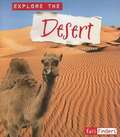- Table View
- List View
Exploration And Conquest: 1500-1620
by Giulio Maestro Betsy MaestroChristopher Columbus was not the first to discover the Americas, but his voyages led to European exploration of the New World. Rich in resources and natural beauty, the Americas were irresistible to gold-hungry conquistadors. The newcomers gave little thought to those who had called the lands their home, and exploration soon came to signify conquest. The New World -- and the lives of its inhabitants -- would be changed forever.
Explorations in ART [Grade 4]
by Eldon Katter Marilyn G. StewartIncludes six units that are organised around universal themes relevant to students' lives, fostering meaningful connections to artworks across time and place. This title provides elements and principles that are embedded throughout various units to ensure continual application and understanding.
Explore (Orca Currents)
by Christy GoerzenWhen Mike Longridge gets himself in trouble yet again, he is given a choice: juvenile detention or an outdoor program called Explore. He opts for Explore, but soon finds himself wondering how he is going to survive ten months with the hippies and keeners in the program. He's never felt so out of place and is certain he will never get the hang of the outdoor activities. Will Mike go back to his old trouble-making ways or will he finally find a place to belong? This short novel is a high-interest, low-reading level book for middle-grade readers who are building reading skills, want a quick read or say they don’t like to read! The epub edition of this title is fully accessible.
Explore Ancient Egypt!
by Carmella Van Vleet Alex KimPyramids, mummies, amulets, temples, and pharaohs- Explore Ancient Egypt! brings this fascinating civilization to young readers ages 6-9 with 25 hands-on projects, activities, and games. Kids learn about ancient Egyptian homes, food, money, toys, games, makeup, clothes, kings, mummies, and more. Projects are easy to follow and require primarily common household products and very little adult supervision.Activities range from making a scarab necklace to writing in ancient Egyptian hieroglyphs and making King Tut sandals. By combining a hands-on element with riddles, jokes, facts, and comic cartoons, kids Explore Ancient Egypt! in this accessible introduction to an incredible, ancient world.
Explore Ancient Greece!
by Carmella Van Vleet Alex KimInvestigate the fascinating civilization of ancient Greece through 25 hands-on projects and activities for young readers ages 6-9. Kids learn about ancient Greek homes, food, playtime, clothing, conquests, arts and entertainment, gods, and more. Activities range from fashioning a model oil lamp from clay to building a courtyard column and constructing a flipbook sailing ship. By combining a hands-on element with riddles, jokes, fun facts, and comic cartoons, kids Explore Ancient Greece! and develop an understanding of how this ancient civilization still influences our modern world.
Explore Ancient Rome!
by Carmella Van Vleet Alex KimInvestigate the fascinating civilization of ancient Rome through 25 hands-on projects and activities for young readers ages 6-9. Kids learn about ancient Roman homes, food, playtime, clothing, conquests, gods, entertainment, and more. Activities range from creating an amphora and making a tunic to baking bread and hosting a Roman feast. By combining a hands-on element with riddles, jokes, fun facts, and comic cartoons, kids Explore Ancient Rome! and develop an understanding of how this ancient civilization laid the foundation of our modern world.
Explore Colonial America!
by Verna Fisher Bryan StoneIn Explore Colonial America!, kids ages 6-9 learn about America's earliest days as European settlements, and how the colonists managed to survive, build thriving colonies, and eventually challenge England for independence.How did the colonists build homes, feed and clothe themselves, and get along with the Native Americans who were already here? This accessible introduction to the colonial period teaches young children about the daily lives of ordinary colonists and offers fascinating stories about those who helped shape the emerging nation. Activities range from creating a ship out of a bar of soap and building a log home out of graham crackers and pretzels to making a wampum necklace. Projects are easy-to-follow, require minimal adult supervision, and use primarily common household products and recycled supplies.By combining a hands-on element with riddles, jokes, fun facts, and comic cartoons, kids Explore Colonial America!, and have a great time discovering our nation's founding years.
Explore Fossils!
by Cynthia Light Brown Grace BrownIn Explore Fossils! With 25 Great Projects, readers can expand their dinosaur obsessions into learning opportunities that take them beyond Triceratops, Stegosaurus, and even Tyrannosaurus rex to other animals, plants, and microbes that lived long before humans. Explore Fossils! introduces young readers to the history of life on Earth as revealed by fossils. Kids learn how fossils form and about the different types of fossils and the world of long ago--its landscape and the plants and animals that lived then. Scientists use radiometric dating to test fossils to discover when they were made, what organisms made them, what those organisms used for energy, what killed them, and a whole lot of other information. All from rocks! That's a lot of information stored under our feet. Activities include creating plaster fossils, using popcorn to illustrate radiometric dating, and exploring what might have caused mass extinctions by making a lava flow and simulating an asteroid impact. By studying the past, not only do students meet amazing plants and animals, they are also encouraged to consider their own role in geological time to make thoughtful hypotheses about the future.
Explore Gravity!
by Bryan Stone Cindy BlobaumHow can something that grounds us and keeps us here on this earth be so invisible and mysterious? We're not talking about anything abstract and undetectable. We're talking about GRAVITY! Gravity is a force that affects everyone and everything. Gravity is something we can easily understand, even kids, especially if they have the right tools to teach them.Explore Gravity! With 25 Great Projects will introduce kids ages 6-9 to the basics of gravity, including concepts of matter, attraction, and gravitational pull. Projects include creating a working model of a scale to learn what "weight" really means and how it's affected by gravity. By playing with various weights to make a marvelous mobile, readers learn about the center of balance and how martial artists use this knowledge to throw their weight around. All the projects in this book are easy to follow, require little adult supervision, and use commonly found household products, many from the recycling box! The fun facts, trivia, jokes, comics, and hands-on activities will help kids discover the captivating science of gravity. Furthermore, the informational text and hands-on activities will excite kids about STEM, the interrelated fields of science, technology, engineering, and math.
Explore Life Cycles!
by Kathleen M. Reilly Bryan StoneExplore Life Cycles! takes kids on an amazing journey, where they'll learn about the changes plants and animals experience throughout their lives. Kids ages 6-9 will discover what happens inside those magical cocoons to transform a caterpillar into a butterfly. They'll explore how frogs breathe underwater as tadpoles, then use lungs as an adult. Explore Life Cycles! will examine how plants and animals are born, develop, and live their lives.Activities range from creating edible life cycles of insects to making a mealworm nursery. Using an eye-catching combination of cartoons, fun facts, and exciting projects, Explore Life Cycles! will bring the mysteries of life right into kids' hands.
Explore Money!
by Bryan Stone Cindy BlobaumIn Explore Money! With 25 Great Projects, money is more than something to earn, save, and spend. It's an opportunity to explore history, art, science, economics, and math! While checking out the change in their pockets and bills from their banks, young readers search for hidden treasures, learn how money can multiply, and see how countries keep their currency secure. Very large and very small numbers take on a new relevance when seen through the lens of money. Using familiar materials found in the home or classroom, young readers explore the cultural aspect of money as well as its physical properties, discovering how these properties have affected business and global relationships throughout history. Kids experiment with various substances to clean coins, scientifically test coin components, design their own currency, and plan how to allocate their own money. Understanding the whats, whys, and hows of currency helps children achieve financial literacy and establish a strong foundation for a healthy, life-long relationship with money. Explore Money! meets Common Core State Standards for literacy in language arts, and mathematics; Guided Reading Levels and Lexile measurements indicate grade level and text complexity.
Explore Night Science!
by Bryan Stone Cindy BlobaumExplore Night Science! encourages 6-9 year olds to safely explore and understand what happens around the world when it is dark outside. Readers are led step by step into integrated, active explorations that uncover the science and technology of the natural and physical world that surrounds them. Kids learn about the rod and cone cells found in their eyes as they test their color vision at night, create a chorus mimicking the sounds of nocturnal animals, and make a personal stardome. Sidebars highlight a real kid who discovered a supernova, how Stonehenge is an ancient almanac, and what elephants and moths have in common.Kids will be amazed at the adaptations used by plants and animals to survive and thrive in the dark of night. Whether they live in the country or in the city, kids will learn to use all of their senses to investigate the night.
Explore Norse Myths!
by Anita YasudaThe stories of Norse myths and legends are a terrific introduction to Viking culture, history, science, and traditions, which thrived in Scandinavia from the eighth to the eleventh centuries. But who were the Norse, who left their homelands in Denmark, Norway, and Sweden to trade, raid, and explore around the world? In Explore Norse Myths! With 25 Great Projects, young readers discover the remarkable people and mythical creatures of old. Learning about Norse myths means unearthing the origin of Viking beliefs, as well as exploring their ships, tools, and other technology that flourished for nearly 450 years. Along the way, kids will read how Norse myths helped explain the natural world from thunder to the seasons, from creation to death. They may be surprised at how Norse myths continue to influence modern culture in the form of movies and books, including the new series by Rick Riordan. Readers will read Norse stories and learn about the adventures of real Norse explorers, including Erik the Red and Leif Erikson. Through a mixture of fun facts, trivia, jokes, comics, and hands-on activities, kids will dig up Scandinavia's past and sail the seas along with the gods and giants in Explore Norse Myths!
Explore Our Land
by Catherine Clinton Sarah Bednarz Michael Hartoonian Arthur Hernandez Patricia L. Marshall Pat NickellExplore Poetry!
by Andi DiehnPoems can be silly, serious, or fun, just like kids! Whether it’s the sing-song rhythm of a limerick, the serendipitous magic of a found poem, the deceptive simplicity of a haiku, or the easy familiarity of an acrostic poem, children are charmed by poetry. And what’s more fun than reading poetry? Writing it! In Explore Poetry! With 25 Great Projects children have fun learning about different forms of poetry while delving into different literary techniques such as personification, metaphor, and alliteration, all of which are discussed in a simple and accessible way. Activities include creative writing exercises designed to reinforce language arts skills, plus art projects that encourage children to visualize concepts and definitions. Short biographies of important poets reinforce the concept of poetry as an important part of society. Explore Poetry! meets Common Core State Standards for language arts; Guided Reading Levels and Lexile measurements indicate grade level and text complexity. Informational and inspiring, Explore Poetry! fits seamlessly into the poetry curriculum of grades 2 to 4 and serves as an enrichment resource all during the school year, especially April, Poetry Month.
Explore Predators And Prey
by Cindy BlobaumHunting, hiding, trapping, and tricking are just a few of the strategies used by animals in the wild to ensure they eat enough without being eaten themselves! In Explore Predators and Prey! With 25 Great Projects, readers ages 7 through 10 explore the physical and behavioral adaptations of predators and prey and their impact on the environment. Predators, such as hawks and foxes, have keen eyesight and sharp beaks and teeth to help them catch their prey. Prey, such as mice and rabbits, have large ears to hear danger and can move quickly to escape their enemies. Animal populations are closely integrated with each other and the surrounding environment. A change to one population causes changes to all others. Readers discover how repercussions can affect nature, including humans, and are encouraged to consider their own actions with an eye toward the effect on the environment. In Explore Predators and Prey, kids actively learn about body tools and behavior strategies as they test their own abilities to hunt and hide in a series of science-minded activities. Fun facts and colorful cartoons make learning entertaining and links to online primary sources and videos make the content accessible to all learners.
Explore Predators and Prey!: With 25 Great Projects
by Cindy Blobaum Matt AucoinHunting, hiding, trapping, and tricking are just a few of the strategies used by animals in the wild to ensure they eat enough without being eaten themselves! In Explore Predators and Prey! With 25 Great Projects, readers ages 7 through 10 explore the physical and behavioral adaptations of predators and prey and their impact on the environment.Predators, such as hawks and foxes, have keen eyesight and sharp beaks and teeth to help them catch their prey. Prey, such as mice and rabbits, have large ears to hear danger and can move quickly to escape their enemies. Animal populations are closely integrated with each other and the surrounding environment. A change to one population causes changes to all others. Readers discover how repercussions can affect nature, including humans, and are encouraged to consider their own actions with an eye toward the effect on the environment.In Explore Predators and Prey, kids actively learn about body tools and behavior strategies as they test their own abilities to hunt and hide in a series of science-minded activities. Fun facts and colorful cartoons make learning entertaining and links to online primary sources and videos make the content accessible to all learners.
Explore Rocks and Minerals!
by Cynthia Light Brown Bryan Stone Nick BrownExplore Rocks and Minerals! offers kids ages 6-9 a fascinating introduction to geology. It investigates the geological forces that create and transform rocks, outlining the life cycle of igneous, sedimentary, and metamorphic rocks, and what they can tell us about the earth. It also explores fossils, and how they come to exist and are discovered.Explore Rocks and Minerals! includes 20 hands-on activities to bring learning to life. Kids create their own crystals, sculpt edible models of the planet, and bake volcanic meringue cookies. These easy-to- follow activities require minimal adult supervision and use common household products. By combining an interactive component with jokes, fun facts, and cartoons, Explore Rocks and Minerals! provides a fun, accessible introduction to geology.
Explore Spring!
by Lauri Berkenkamp Alexis Frederick-FrostFrom tracking spring peepers and raising tadpoles to learning about seeds and recording plant growth, Explore Spring! 25 Great Ways to Learn About Spring invites young readers to explore the wonders of spring by becoming scientists in the field. Combining hands-on learning with solid science, trivia, riddles, and terrific illustrations, projects investigate "the reason for the season" and include identifying trees and measuring their growth, recording soil temperature, and observing the forest floor. Bird migration and nest building are covered, and the movement of air and water is studied with experiments in capillary action and in such activities as "Making Parachutes," Making Kites," and "Mapping Air Currents with Bubbles."
Explore Weather and Climate!
by Bryan Stone Kathleen M ReilleyWhat's it like outside? And what are you going to do about it?Every morning, before heading to school or out to play, kids want to know what the weather is going to be like that day. Is it a day for building a snowman, constructing a sandcastle, or planting a garden? Will they be stuck inside because of rain at recess? Or stuck at home because of snow? And what about tomorrow? Explore Weather and Climate! will help kids understand the "how" and "why" behind the "what." They'll learn how wind, sun, and water combine to form the weather we experience every day. They'll find out why the weather gets extreme. Explore Weather and Climate! offers engaging text reinforced with 25 hands on projects that include creating a storm in a bottle, touching the clouds, and eating an edible climate map, resulting in an unforgettable understanding of these forces of nature.
Explore Winter!
by Maxine Anderson Alexis Frederick-FrostYoung readers become scientists in the field when this activity book sends them off to answer the question "Why do we have winter?" with experiments and projects that mix real science with real fun. Combining hands-on learning with trivia, jokes, riddles, and terrific illustrations, chapters start with the "tools" of science-the scientific method and how to keep a science journal-and then investigate the winter constellations, long nights and long shadows, animal tracking in snow, and food-gathering behavior in birds.
Explore Winter!: 25 Great Ways to Learn About Winter
by Maxine Anderson Alexis Frederick-FrostYoung readers become scientists in the field when Explore Winter! sends them off to answer the question "Why do we have winter?" with experiments and projects that mix real science with real fun. Combining hands-on learning with trivia, jokes, riddles, and terrific illustrations, chapters start with the "tools" of science-the scientific method and how to keep a science journal-and then investigate the winter constellations, long nights and long shadows, animal tracking in snow, and food-gathering behavior in birds.
Explore the Bible: The Life of Christ Student Textbook
by Purposeful DesignThis book helps students explore Jesus' life through 40 individual lessons incorporated into a student textbook.
Explore the Desert (Explore the Biomes Ser.)
by Kay JacksonDiscusses the plants, animals, and characteristics of the desert biome.
Explore the Salish Sea: A Nature Guide for Kids
by Joseph K. Gaydos Audrey DeLella BenedictFilled with beautiful photography and engaging text, Explore the Salish Sea inspires children to explore the unique marine ecosystem that encompasses the coastal waters from Seattle's Puget Sound up to the Strait of Juan de Fuca and the Georgia Strait of British Columbia.Discover the Salish Sea and learn about its vibrant ecosystem in this engaging non-fiction narrative that inspires outdoor exploration. Filled with full-color photography, this book covers wildlife habitats, geodiversity, intertidal and subtidal sea life, and highlights what is unique to this Pacific Northwest ecosystem.
